The Brazos Review: AMD's E-350 Supplants ION for mini-ITX
by Anand Lal Shimpi on January 27, 2011 6:08 PM ESTHeavy Lifting: Performance in Complex Workloads
Brazos is clearly faster than Atom in light workloads, but what about in more complex/heavier applications? Are the Bobcat cores enough to allow E-350 systems to move up in the world or will they still be confined to the web browsing/email usage models of netbooks? I've run the E-350 through our entire Bench suite to find out. If you want the full gamut of results head over to CPU Bench, but I've chosen a few here. I also included performance results from a 2.66GHz Pentium 4 to put things in perspective for users of really old systems.
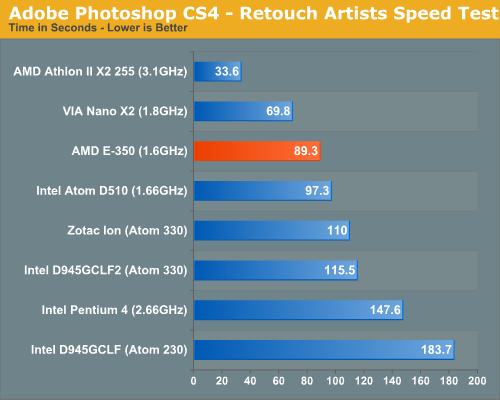
Photoshop CS4 performance is not half bad on the E-350 compared to other similarly priced platforms. Also impressive is the E-350's performance advantage over the old Pentium 4. Compared to the Athlon II X2 however the E-350 is still noticeably slower.
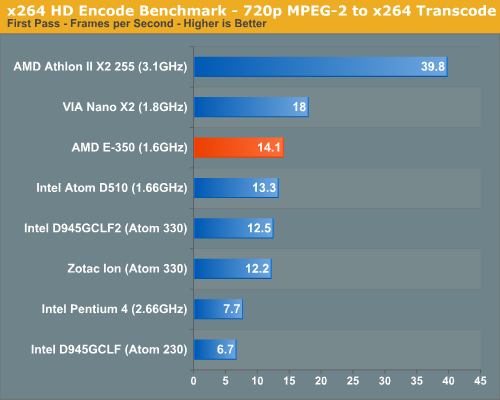
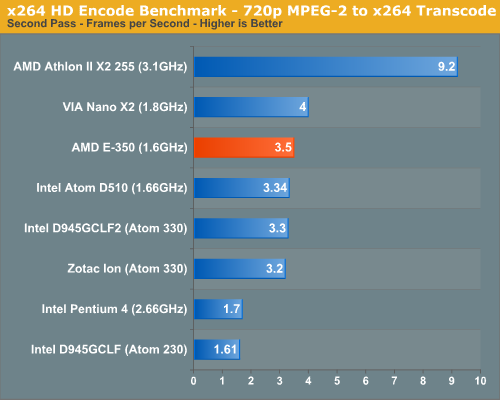
The standings and performance trends continue in our x264 encode benchmark. I don't expect you to do a lot of video transcoding on the E-350 as it's not much faster than Atom here. VIA's dual-core Nano is a bit quicker but still not enough to make this a viable usage case.
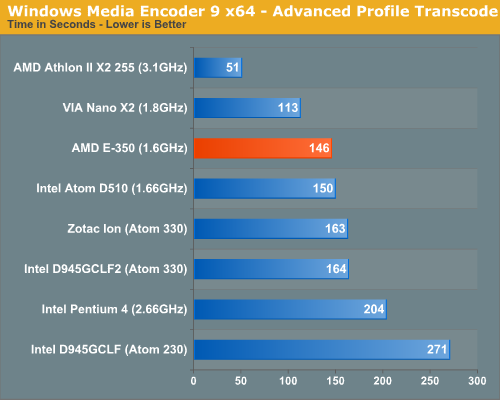
Windows Media Encoder provides a far lighter workload, but the standings don't change. The E-350 is faster than anything Atom based, faster than the old Pentium 4, but slower than VIA's Nano X2.
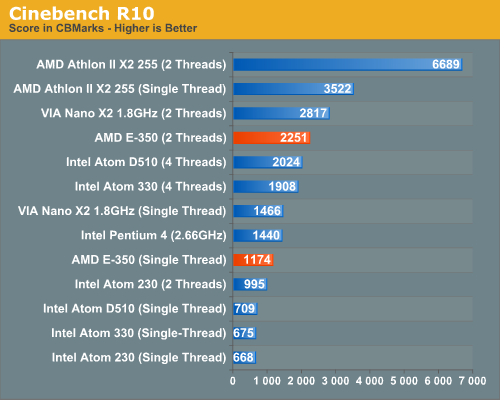
While I don't expect E-350 users to do any offline 3D rendering work, Cinebench does give us a good characterization of single threaded performance. The problem with Atom is that its single threaded performance isn't nearly as good as its multithreaded performance. In all of the previous benchmarks an Atom D510 is clearly quicker than the old 2.66GHz Pentium 4, but looking at single threaded Cinebench R10 you get a different story entirely. The P4 has nearly twice the single threaded performance of an Atom D510.
The E-350 is still a bit behind the Pentium 4 in single threaded performance, but it's not nearly as bad as Atom. The out-of-order execution engine helps tremendously here. What you get as a result is a system that doesn't really feel slower than a 5 year old PC but has the features of a more modern system.
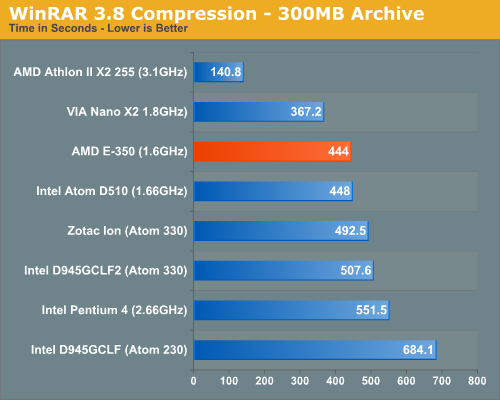
Overall the E-350 is clearly faster than Atom ever was at running these heavier workloads. The highly threaded workloads aren't much faster on E-350 vs. Atom thanks to the latter's Hyper Threading , but single threaded performance continues to play an important role and is a huge advantage of AMD's. VIA's simple out-of-order architecture is consistently faster than the E-350, however I don't expect to see widespread adoption or support for VIA's platform (at least compared to AMD's). Compared to the larger out-of-order x86 cores the E-350 is still in a lower performance class, the Athlon II X2 is easily twice as fast as the E-350 in these tests.
Ultimately the same rules that applied to Atom based systems apply to Brazos systems:
1) Swapping to disk is painful so you need enough memory (I'd recommend no less than 2GB for Windows 7, ideally 4GB) and you'll want a fast HDD. My preference is still an SSD, even a low end value drive over even a fast hard drive. Even a low end SSD (e.g. Kingston SSDNow V100) will make a Brazos system feel acceptably fast.
2) Outside of media playback and some gaming, you're still limited in the types of applications and workloads you can run on Brazos. The Brazos platform is great for web browsing/email workloads, but don't try to do too much more with it. The advantage over Atom here is that Brazos just does those things noticeably faster.










176 Comments
View All Comments
DanaG - Friday, January 28, 2011 - link
One thing I'm wondering: how does Brazos compare to Atom and ARM (such as QNAP TS-219P+) on power usage and network performance? From reviews of ARM devices, it looks like they hit a speed limit that may be caused by the SoC devices themselves.I do know that Realtek Gigabit Ethernet sucks, so it'd be worthwhile to benchmark with an Intel NIC and a Broadcom NIC, as well.
Aone - Friday, January 28, 2011 - link
I reckon Anand Lal Shimpi should know that neither Atom D510 nor Atom 330 supports EIST or Idle Power State. If he does compare the power consumtion he, at least, must mention it.And i'm not sure that Atom platform supports DDR3-1333 as Brazos. Usually Atom sticks with DDR2-667.
Unfortunately, mem config is absent from description of test configs.
DanNeely - Friday, January 28, 2011 - link
DDR3-800 based atoms launched a few months back; the performance difference vs their DDR2 siblings was negligible.krish123 - Friday, January 28, 2011 - link
Hi Anand,You are comparing the gaming performance of Core I5 2500K / higher clocked graphics with E350, but u should also show the power consumption/price difference on those parts. .. I feel ., kind of biased review, when you are trying to compare only the positive side of intel parts and not the negative side
I will wait for your review on Llano and bulldozer
Regards,
Kicha
7Enigma - Friday, January 28, 2011 - link
Did you even read the text or just look at the pretty graphs?The i5 is in there as a bracketing agent so that those of us with desktop systems can get a feel for the performance difference to these Atom/APU products. There was never a direct comparison drawn unless you ignore all the text and just stare at the pictures.
OneArmedScissorB - Friday, January 28, 2011 - link
Did you even read the pretty graphs? They were very nearly neck and neck in those comparisons. Why omit the most significant differentiation between the two?Sandy Bridge and Bobcat as HTPC platforms are more comparable than anything else. They are both at least "good enough" for general use, have similar IGP and video acceleration capabilities, and are both readily available in mini-ITX.
And yet, there's a 3.1 GHz Athlon II X2 with an 890GX board in the power results, likely full size ATX, in place of every single last one of the numerous mini-ITX platforms they could have just copied and pasted into the chart from past articles. Wtfbbq?!?
That was not just an oversight, but a very significant mistake that detracts from the usefulness of the entire article.
bjacobson - Saturday, January 29, 2011 - link
hm, that seems a bit of an overstatement. I don't really see how the 2500's are at all in the same market as this.code65536 - Friday, January 28, 2011 - link
I wonder, does Bobcat support hardware-assisted virtualization?silverblue - Friday, January 28, 2011 - link
I read that it does.macs - Friday, January 28, 2011 - link
Can someone test the power consumption of an i3 2100 on itx mobo? I suppose it will be quite close to brazos, at idle at least